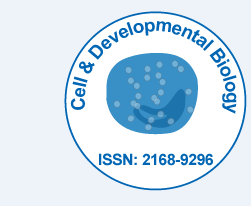
Cell & Developmental Biology
Open Access
ISSN: 2168-9296

ISSN: 2168-9296
Commentary Article - (2024)Volume 13, Issue 1
Acute Myeloid Leukemia (AML) represents a formidable challenge in the realm of oncology, characterized by the rapid proliferation of abnormal myeloid cells in the bone marrow. Among the diverse genetic aberrations associated with AML, the fusion gene BCR-ABL1 stands out, carrying profound implications for both diagnosis and treatment. Allogeneic Hematopoietic Cell Transplantation (allo-HCT) emerges as a important therapeutic modality offering a potential cure for AML patients harboring the BCR-ABL1 fusion gene.
Understanding AML with BCR-ABL1 fusion
The fusion between the Breakpoint Cluster Region (BCR) and Abelson 1 (ABL1) genes results from a chromosomal translocation, most commonly t(9;22)(q34;q11.2), known as the Philadelphia chromosome. This fusion gene produces a constitutively active tyrosine kinase, driving uncontrolled cell proliferation and inhibiting apoptosis are the features of leukemia.
Patients diagnosed with AML carrying the BCR-ABL1 fusion gene often face a more aggressive disease course and poorer prognosis compared to those without this genetic aberration. Traditional chemotherapy regimens, while effective to some extent, often fail to achieve durable remissions in these cases, necessitating the exploration of alternative treatment strategies.
Role of allogeneic hematopoietic cell transplantation
Allo-HCT represents a curative approach for various hematological malignancies, including AML. This procedure involves the infusion of hematopoietic stem cells from a healthy donor, which can reconstitute the recipient's bone marrow and immune system, effectively eradicating leukemic cells.
Advantages
Graft Versus Leukemia (GVL) effect: Allo-HCT harnesses the potent immunological response of donor T cells against residual leukemia cells, known as the GVL effect. This mechanism is particularly beneficial in eliminating leukemic clones expressing the BCR-ABL1 fusion protein.
Overcoming chemotherapy resistance: AML with BCR-ABL1 fusion often exhibits resistance to conventional chemotherapy due to the oncogenic nature of the fusion protein. Allo-HCT provides an alternative therapeutic approach independent of chemotherapy, potentially overcoming resistance mechanisms.
Elimination of Minimal Residual Disease (MRD): Despite achieving remission with chemotherapy, many AML patients may suffer with MRD, which predisposes them to relapse. Allo- HCT offers the opportunity to eliminate MRD through the graft versus leukemia effect, reducing the risk of disease recurrence.
Challenges and considerations
Transplant-related complications: Allo-HCT is associated with significant risks, including Graft Versus Host Disease (GVHD), infections, and transplant-related mortality. Careful patient selection and risk stratification are essential to optimize outcomes.
Relapse post-transplant: Despite the GVL effect, relapse remains a significant concern following allo-HCT, particularly in highrisk AML subtypes such as those with BCR-ABL1 fusion. Novel strategies incorporating targeted therapies or immune checkpoint inhibitors may mitigate this risk.
Donor selection and availability: Identifying a suitable donor, preferably a Human Leukocyte Antigen (HLA)-matched sibling or unrelated donor, is critical for successful allo-HCT. However, donor availability may face challenges, particularly for ethnically diverse populations.
Future directions
The landscape of AML treatment, including cases with BCRABL1 fusion, continues to evolve rapidly. Ongoing research efforts focus on optimizing allo-HCT protocols, enhancing posttransplant monitoring strategies, and integrating novel targeted therapies to improve outcomes and reduce treatment-related toxicities.
Advances in genetic profiling and minimal residual disease monitoring offer the potential for more personalized treatment approaches, customized therapy based on individual risk profiles and disease characteristics. Furthermore, the origin of targeted agents specifically inhibiting the BCR-ABL1 fusion protein, such as Tyrosine Kinase Inhibitors (TKIs), improves outcomes of both pre- and post-transplants.
Allogeneic hematopoietic cell transplantation represents a fundamental way in the management of acute myeloid leukemia with BCR-ABL1 fusion, offering the prospect of long-term disease control and even cure. It offers the possibility of a cure by replacing the patient's diseased bone marrow with healthy donor cells, effectively eliminating leukemic cells and restoring normal hematopoiesis. However, multidisciplinary collaboration, ongoing research, and innovative therapeutic strategies are imperative to address the challenges and further optimize outcomes in this patient population.
Citation: Gao T (2024) Allogeneic Stem Cell Transplantation for BCR-ABL1 Fusion-Positive Acute Myeloid Leukemia. Cell Dev Biol.13:331.
Received: 15-Feb-2024, Manuscript No. CDB-24-30689; Editor assigned: 19-Feb-2024, Pre QC No. CDB-24-30689 (PQ); Reviewed: 04-Mar-2024, QC No. CDB-24-30689; Revised: 11-Mar-2024, Manuscript No. CDB-24-30689 (R); Published: 18-Mar-2024 , DOI: 10.35248/2168-9296.24.13.331
Copyright: © 2024 Gao T. This is an open-access article distributed under the terms of the Creative Commons Attribution License, which permits unrestricted use, distribution and reproduction in any medium, provided the original author and source are credited.